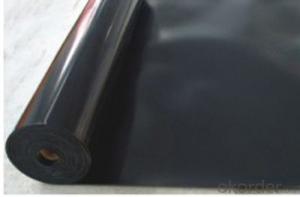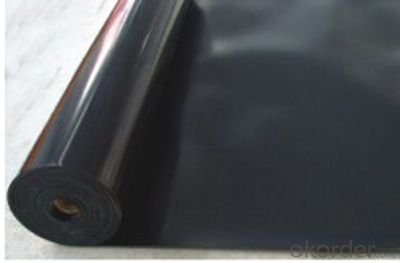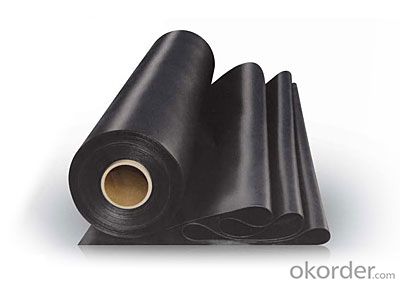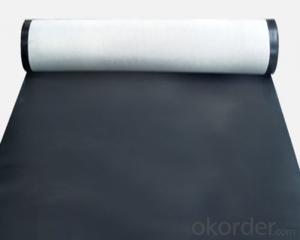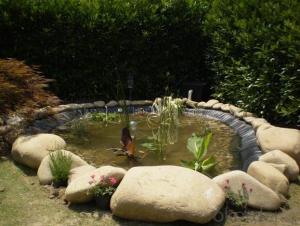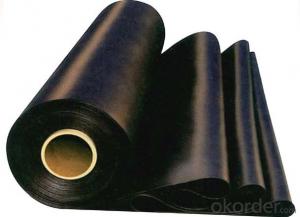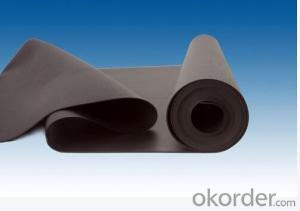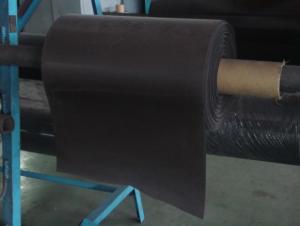Epdm Rubber Waterproofing Membrane for Roof
- Loading Port:
- China main port
- Payment Terms:
- TT OR LC
- Min Order Qty:
- 5000 m²
- Supply Capability:
- 100000 m²/month
OKorder Service Pledge
OKorder Financial Service
You Might Also Like
1.Structure of Epdm Rubber Waterproofing Membrane Description:
Epdm waterproofing materials is a new kind of high polymer waterproof material, using the du pont production,excellent aging resistance of epdm rubber, as main material.It has excellent quality.The product has excellent physical and mechanical properties, high breaking,high elongation rate, high tear strength, ageing resistance, ozone resistance, cold resistance and low water absorbability, stable quality, reliable. Various technical indexes reach or exceed the index set by the state.It's suitable for all kinds of waterproof and overlying protective layer of roofing, basement, reservoir, toilet rooms, tunnel, subway, bridges, DAMS and other waterproof engineering.
2.Atention:
• When it comes across rain, snow, fog, strong wind ,it cannot be coil construction.
• Coil adhesive volatile.When construction, it should be along with it into a container. Packaging barrels should be closed in time, and binder should be shaked when using rear can be used.
• When it's in construction ,it should be far away from fire and heat source.
3.Main Features of Epdm Rubber Waterproofing Membrane:
•Excellent anti-aging performance, chemical corrosion resistance, it can be applied to special occasions, the service life of is up to 50 years.
•High elongation and higher tensile strength ,small heat treatment size changing ;
•Special molecular structure of modified, it is effectively to solve the shortage problems of adhesive lap;
•Good flexibility in low tempreture, adapting to the environment temperature changes;
•Construction is convenient, lap joint is firm and reliable, and no environment pollution.
4.Epdm Rubber Waterproofing Membrane Specification:
| thickness | 1.2 | 1.5 | 2.0 | |
| width | 1.0 | 1.2 | 20 | |
| lenth | 20 | |||
| area | 20 | 24 | ||
5.Epdm Rubber Waterproofing Membrane Imges:
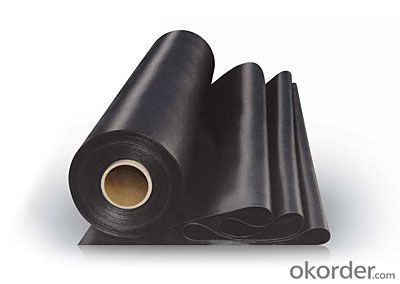
- Q: Can a waterproofing membrane be used on cinder block surfaces?
- Yes, a waterproofing membrane can be used on cinder block surfaces. Cinder blocks are porous materials that can absorb water, so applying a waterproofing membrane can help prevent moisture from penetrating the surface and causing damage. The membrane acts as a barrier, preventing water from infiltrating the cinder blocks and protecting them from moisture-related issues such as mold, mildew, and deterioration. It is important to properly prepare the cinder block surface before applying the membrane to ensure proper adhesion and effectiveness. Additionally, choosing a waterproofing membrane specifically designed for cinder block surfaces will provide the best results.
- Q: Waterproof basement is empty shop or full shop
- A waterproof, full of sticky. Secondary, sticky or sticky. Construction waterproof with waterproof material.
- Q: Can a waterproofing membrane be used for water features or fountains?
- Yes, a waterproofing membrane can be used for water features or fountains. Waterproofing membranes are designed to prevent water from penetrating into the underlying structures, making them suitable for creating a watertight barrier in water features or fountains.
- Q: Can a waterproofing membrane be used in fountains or water features?
- Yes, a waterproofing membrane can be used in fountains or water features. Waterproofing membranes are designed to protect surfaces from water penetration and are commonly used in various construction applications, including fountains and water features. These membranes create a barrier that prevents water from seeping into the underlying structure, ensuring the longevity and functionality of the fountain or water feature. Additionally, waterproofing membranes can be applied to different materials, such as concrete, stone, or metal, making them versatile for use in various designs and styles of fountains or water features.
- Q: Can a waterproofing membrane be used in conjunction with sustainable construction materials?
- Indeed, the use of a waterproofing membrane alongside sustainable construction materials is gaining traction in the construction industry. This is due to the growing emphasis on environmentally friendly and energy-efficient buildings. Waterproofing membranes serve to safeguard sustainable construction materials, such as recycled or low-impact materials, against water damage and moisture infiltration. By forming a barrier, these membranes prevent water from permeating the materials, thereby extending their lifespan and reducing the necessity for repairs or replacements. Furthermore, sustainable construction materials are often engineered to enhance energy efficiency, which can be further augmented through the employment of a waterproofing membrane. By averting water damage, the membrane upholds the structural integrity of the building envelope, curbing potential energy loss from leaks or moisture intrusion. In addition, specific waterproofing membranes are designed with sustainability in mind. For instance, there are eco-friendly membranes fabricated from recycled materials or those that can be recycled at the end of their life cycle. These sustainable membranes minimize the environmental impact associated with their production and disposal. In conclusion, the integration of a waterproofing membrane in conjunction with sustainable construction materials is a wise and conscientious approach to building design. It ensures the long-term durability and performance of the materials, while also contributing to a more sustainable and energy-efficient built environment.
- Q: Are there any specific fire safety considerations for using a waterproofing membrane?
- Using a waterproofing membrane requires specific fire safety considerations. Although these membranes are designed to protect structures from water and moisture-related issues, they can also pose fire safety challenges. To begin with, it is important to evaluate the fire resistance rating of the waterproofing membrane. Building codes and regulations often mandate specific fire resistance ratings for different components of a building, such as roofing and wall systems. Therefore, it is necessary to assess the fire resistance rating of the waterproofing membrane to ensure compliance with these requirements. Moreover, the installation process of a waterproofing membrane involves the use of flammable materials like adhesives and sealants. It is crucial to choose fire-resistant materials and employ proper installation techniques to minimize the risk of fire hazards. Furthermore, the presence of a waterproofing membrane can impact the spread of fire and movement of smoke within a structure. It is essential to consider how this affects fire compartmentalization, evacuation routes, and the overall fire safety strategy of the building. Additional fire protection measures, such as fire barriers, smoke management systems, or fire-rated enclosures, may be necessary to compensate for the presence of the waterproofing membrane. Regular inspections and maintenance of the waterproofing membrane are also vital. Over time, the membrane can degrade, crack, or sustain damage, compromising its fire-resistant properties. Therefore, routine inspections and timely repairs or replacements are necessary to maintain the desired level of fire safety. In conclusion, ensuring fire safety when using a waterproofing membrane involves evaluating the fire resistance rating, using fire-resistant materials during installation, assessing the impact on fire spread and smoke movement, and implementing proper maintenance practices. These considerations are crucial for maintaining overall fire safety when utilizing a waterproofing membrane in a building.
- Q: Are waterproofing membranes resistant to battery acid?
- Waterproofing membranes do not usually possess the necessary resistance against battery acid. Their main function is to create a barrier against water and moisture, and they are typically composed of materials like bitumen, rubber, or modified asphalt. Although these materials may exhibit some level of acid resistance, they are not typically engineered to endure the corrosive nature of battery acid. Battery acid, commonly sulfuric acid, can inflict substantial harm on various materials, including waterproofing membranes. If you are dealing with battery acid or find yourself in a situation where exposure to battery acid is a concern, it is advisable to employ materials specifically designed to withstand the corrosive effects of battery acid or seek professional assistance for appropriate solutions.
- Q: Can a waterproofing membrane be used on precast insulation surfaces?
- Yes, a waterproofing membrane can be used on precast insulation surfaces. A waterproofing membrane is designed to provide a protective barrier against water infiltration, and it can be applied to a variety of surfaces, including precast insulation. The membrane helps to prevent water from seeping into the insulation, which can cause damage and reduce its effectiveness. By applying a waterproofing membrane to precast insulation surfaces, you can ensure that the insulation remains dry and maintains its thermal properties over time.
- Q: Can a waterproofing membrane be used in parking garages?
- Yes, a waterproofing membrane can be used in parking garages. Parking garages are exposed to various weather conditions, including rain and snow, and are often subjected to heavy vehicular traffic, which can lead to moisture infiltration and damage to the structure. Therefore, it is crucial to install a reliable waterproofing system to protect the parking garage against water penetration and potential structural deterioration. A waterproofing membrane is an effective solution for parking garages as it acts as a barrier against water and moisture. It is typically made of materials such as modified bitumen, PVC, or EPDM, which are durable and resistant to water intrusion. The membrane is applied to the surface of the concrete structure, creating a protective layer that prevents water from seeping through. The waterproofing membrane not only safeguards the parking garage against water infiltration but also helps to extend the lifespan of the structure. By preventing moisture from penetrating the concrete, it reduces the risk of corrosion, reinforcing steel deterioration, and the formation of cracks. This ultimately helps to maintain the structural integrity of the parking garage and avoid expensive repairs or replacements in the future. Additionally, a waterproofing membrane can also provide added benefits such as resistance to chemicals, UV radiation, and abrasion. This makes it an ideal solution for parking garages that are exposed to harsh environmental conditions and heavy traffic. In summary, a waterproofing membrane is highly recommended for use in parking garages as it offers reliable protection against water infiltration, helps to maintain the structural integrity of the garage, and extends its lifespan.
- Q: How do waterproofing membranes adhere to surfaces?
- Waterproofing membranes adhere to surfaces through a combination of mechanical and chemical bonding. The surfaces must be clean, dry, and free from any loose particles or contaminants before the membrane is applied. In terms of mechanical bonding, many waterproofing membranes have a textured or rough surface that allows for a better grip on the substrate. This texture creates more contact points between the membrane and the surface, increasing the adhesion strength. Additionally, some membranes have a self-adhesive backing that allows them to stick directly to the substrate without the need for additional adhesives. Chemical bonding also plays a crucial role in adhesion. Waterproofing membranes are often made from materials such as modified bitumen, EPDM rubber, or PVC, which have inherent adhesive properties. These materials are designed to create a chemical bond with the substrate, creating a strong and durable seal. In some cases, additional adhesives or primers may be required to enhance the adhesion of the waterproofing membrane. These products are specifically formulated to promote a stronger bond between the membrane and the surface, ensuring long-lasting waterproofing protection. Overall, the adhesion of waterproofing membranes to surfaces is achieved through a combination of mechanical and chemical bonding, along with the use of specialized adhesives or primers when necessary. This ensures that the membrane is securely attached to the substrate, preventing water from penetrating and causing damage.
Send your message to us
Epdm Rubber Waterproofing Membrane for Roof
- Loading Port:
- China main port
- Payment Terms:
- TT OR LC
- Min Order Qty:
- 5000 m²
- Supply Capability:
- 100000 m²/month
OKorder Service Pledge
OKorder Financial Service
Similar products
Hot products
Hot Searches
Related keywords
